79% of consumers prefer seeing contextual ads over behavioral ones.
In this article, we will discuss what is contextual advertising, why it matters, and how you can implement it into your marketing strategy. Plus, we will dive into the different contextual marketing types and share the best platforms to get your targeted ads in front of the right audience.
By the end, you’ll be ready to make contextual advertising a key part of your digital marketing toolkit to increase your engagement and conversions.
What Is Contextual Advertising?
Contextual advertising refers to the ads placed on web pages based on users’ content viewing. Think about showing a laptop ad on a tech eCommerce site or promoting running shoes in a news article about an upcoming marathon.
How does contextual and behavioral targeting differ from one another?
Unlike behavioral advertising, where marketers go after consumers based on past behavior, these ads align perfectly with the page’s content or theme. This advertising strategy is more effective since the ads feel more like a helpful suggestion than a sales pitch.
Another big reason for their recent popularity is that they address your consumers’ data privacy concerns. It does not rely on tracking user behavior through third-party cookies, which protects your customers’ identities and personal information.
8 Must-Know Types Of Contextual Advertising
As you explore each type, focus on the ones that stand out to you, and plan how you can incorporate them into your marketing efforts to deliver relevant ads that match your content.
1. Programmatic Native Advertising
Programmatic native advertising involves buying and placing ads in real-time auctions on websites using automated systems. This ad type matches the style and format of the web page content they appear in to create a smoother experience for your target audience.
Amazon does a great job using programmatic advertising to show product recommendations that perfectly match what users are browsing. With Amazon DSP, you can easily target customers contextually like this:
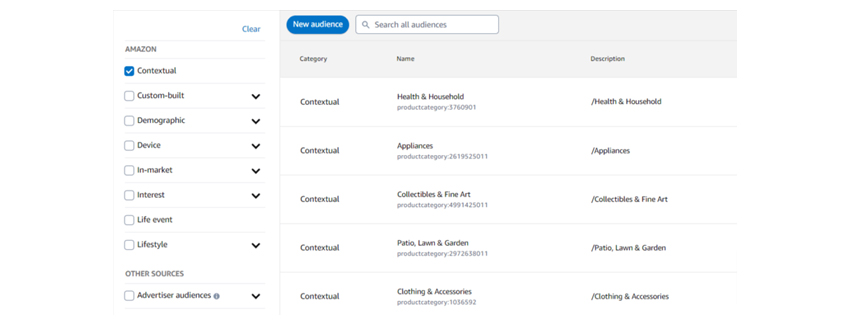
For example, let’s say you sell skincare products. You can target the beauty and personal care category on Amazon to show your ads on all skincare-related listings.
2. Semantic Contextual Ads
Semantic contextual ads take online ads a step further since they go beyond simple keyword matching. They understand the broader context of the page’s content.
For example, a regular contextual ad can show a coffee promo on a page about coffee shops. Meanwhile, a semantic ad can understand that an article about staying energized could also be a good fit for a coffee ad.
With this advertising strategy, you can align ads with the deeper context and make them more relevant to your audience.
3. Category Contextual Ads
Category contextual ads target the website’s broader category to serve promos that align with the audience’s general interests. This way, you can capture interest across multiple related topics to give your ads more chances to connect.
Here’s an example:

The ad taps into the broader market and finance category, where energy naturally fits in. It is spot-on for readers who follow market trends and are likely curious about energy topics too.
4. Keyword Contextual Ads
Keyword contextual ads focus on matching the ads to specific terms found within the web page’s content. You can use this to guarantee that the ads directly relate to the content your target audience is engaged with.
For example, you can have an ad about running shoes show up on a blog post about marathon training, where keywords like “running” or “endurance” are mentioned.
What does this do for you?
This means the ads show up when the readers are most receptive. So when you serve contextual ads using keyword targeting, you are more likely to generate clicks and increase your conversions.
5. In-Game Contextual Ads
These ads integrate into online games. They align perfectly with the gameplay, mirror the player’s actions, share the same target audience, or fit the overall theme.
The ads enhance the gaming experience with their contextual relevance rather than disrupting the gamer’s flow with unrelated promotions.
Here’s a great example from ABCya:
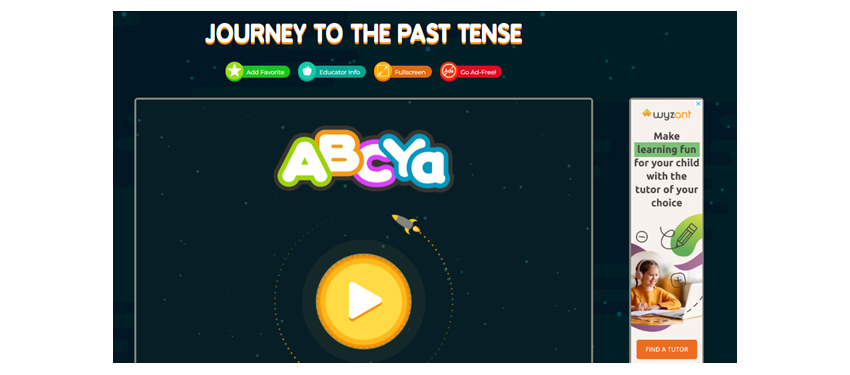
The ad for Wyzant, a tutoring service that aims to make learning fun for kids, aligns well with the game’s educational theme. It is also relevant to the target audience—parents or guardians who are interested in educational tools for their children.
6. Video Contextual Ads
Video contextual ads are displayed within videos or alongside other content. For instance, if you watch a cooking tutorial on YouTube, you may see an ad for kitchen gadgets or meal kits.
If you do not put these ads within other videos, you can do it this way:
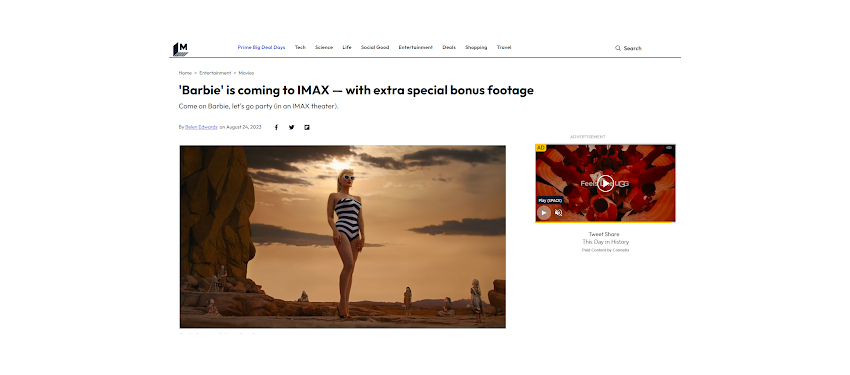
The article is about the Barbie movie, and there is a video ad for UGG clothing, which aligns with the fashion interest likely shared by the movie’s audience.
Additionally, in-video contextual advertising has made its way to TikTok. Its Pulse feature lets companies place their relevant ads next to the top 4% of viral content. With 1.5 billion users on TikTok, this gives brands a chance to connect with a massive audience.
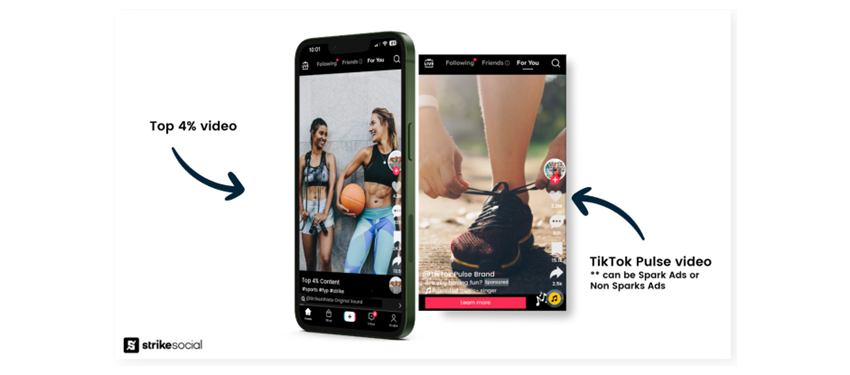
7. Image-Based Contextual Ads
Image-based contextual ads feature photos and are displayed on websites or apps in a way that aligns with the surrounding content. These ads are contextually relevant to the page’s subject matter to make sure that the images resonate with what the viewer is already interested in.
For example, an ad featuring a stylish coffee table can be displayed on a home decor blog. The goal is to make the ad feel like a natural extension of the content to catch the viewer’s attention and engagement.
8. Text-Based Contextual Ads
Text-based contextual ads include different categories tailored to specific user interactions:
- Native Ads: These ads fit naturally within the page’s content. For example, you may find an ad for a streaming service embedded within a BuzzFeed article about binge-worthy TV shows.
- Ad-Oriented Chatbots: These are interactive chatbots that display ads or promotions. They provide recommendations, answer questions, or guide customers through a purchasing process—all while subtly promoting relevant ads or offers.
- Paid Search Ads: These ads appear on search engine results pages (SERPs) and are based on the keywords users search for. For example, searching for “best laptops” on Google can bring up ads from major brands like HP.
7 Steps To Implement Contextual Advertising
Highlight the actionable points and gather your team to brainstorm on how to implement these steps to maximize the ad opportunities that come your way.
Step 1: Analyze Your Content
Understand your website’s content. So assess elements like metadata, images, and text to help web crawlers categorize your content. With this, they can determine where and how your contextual ad campaigns will be placed.
How to Do It
Use a tool like Yoast SEO to analyze your content structure. Look at whether your images have alt text, and if your metadata (like title tags and meta descriptions) are optimized with relevant keywords. With this, you can see the state of your content’s overall structure.

Then, apply the needed changes and structure your content in a way that is easy to crawl. Make sure your headings (H1, H2) reflect the main topics of your content, and make sure that your images have descriptive alt text that relates to the content.
To make these steps easier on you, we at Brandignity can help you with content curation. We can create your web copy and blog post and guarantee they are structured correctly.
Step 2: Match Your Keywords
Keywords are the backbone of contextual targeted advertising. Your ad platform uses machine learning algorithms to match ads with the keywords in your content. So use the right keywords to make sure the ads are displayed on the most relevant pages.
How to Do It
Use Google Keyword Planner to find keywords that your audience is searching for. Enter your content topic to discover related keywords, their search volumes, and competition levels.
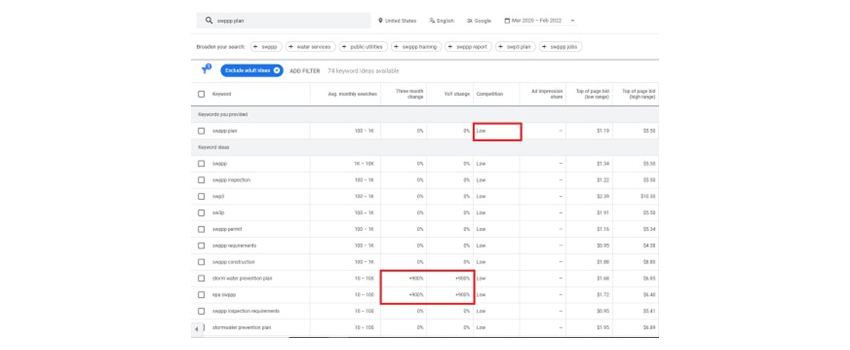
Once you have a list of relevant keywords, incorporate them naturally into your content. Focus on placing them in the title, headings, and throughout the body of your text without overstuffing.
Review the keyword density to make sure you are using keywords effectively without spamming. Aim for a keyword density of 1-2% of your total word count.
Of course, if you partner with Brandignity, this will be all taken care of so you do not have to worry about keywords. We can make sure that relevant terms are included throughout your web content.
Step 3: Place Your Ads On The Web Page
Once your content is optimized, you need to strategically place your ads on your web pages. To nail how contextual advertising works, you want to position your ads where they naturally fit with the relevant content and keywords.
How to Do It
Sign up for Google AdSense to automatically allow and place ads on your website that match your content’s keywords.
How to Create Google AdSense Account (2024) Tutorial For Beginners

Use the AdSense interface to choose where ads will appear on your page. For example, you might prefer ads to show up within the text, in the sidebar, or at the end of articles.
Also, leverage the platform’s reports to see which ad placements generate the most clicks and adjust accordingly. Look for areas where users spend the most time on your page and consider placing ads there.

Now, you have more important tasks to do than monitoring reports. So it is best if you hire a marketing assistant to help you carry the load. They can track the results and compile their findings to make it easier for you to make decisions.
Step 4: Display Relevant Ads Based On User Interaction
To maximize engagement, your ads need to respond to how users interact with your content. The more relevant the ad is to their current activity, the higher the chance they will click on it.
How to Do It
Turn on the Auto Ads feature on your AdSense account. This feature uses machine learning to determine the best placements for your ads based on user behavior.

You should also create experiments within AdSense to know which ad settings perform best. Then, monitor engagement rates to decide on the most effective format.
Step 5: Measure The Click-Through Rate
Measure the success of your contextual ads through the click-through rate (CTR). Use this to know how often people click on your ads. A high CTR indicates that your ads are resonating with the audience, confirming that your contextual targeting is on point.
How to Do It
Connect your AdSense account to Google Analytics. Here’s how:
How To Link Google Analytics to Google Adsense (In Less Than 4 Minutes)

Then, if you want, you can also download your ad data from Google Analytics to see your CTR data.
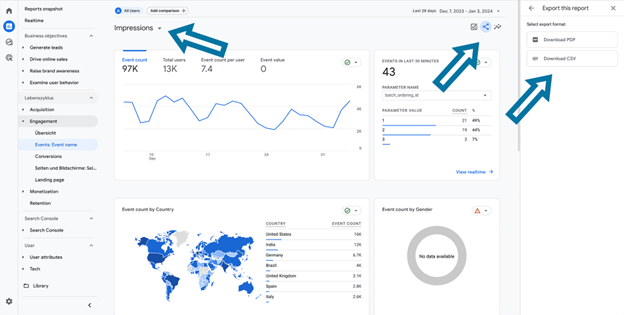
So, what result are you looking for?
A good CTR varies by industry, but generally, aim for 2% or higher. If your CTR is low, revisit your keywords and placement.
Step 6: Regularly Assess & Optimize Your Contextual Ads
Continuously monitor and optimize to maintain your contextual ads’ effectiveness. This step lets you fine-tune audience targeting and adjust ad placements to match relevant content more accurately.
With this, you can keep your ads engaging and relevant to your audience to improve your CTR and overall revenue.
How to Do It
Plan to review your ads weekly or monthly. Look at metrics like CTR, conversion rates, and revenue. Doing this regular assessment guarantees that your ads remain relevant and effective as your content or audience evolves.
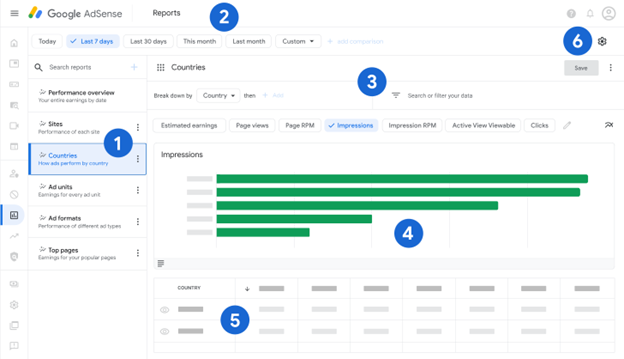
But what if an ad is not performing well? Here’s where to start:
- Check for Ad Overload: Too many ads on a page can overwhelm visitors and reduce effectiveness.
- Optimize Ad Placement: Review where the ads are placed on your site. Ads placed in more visible areas, like above the fold or within content, tend to perform better.
- Analyze Content Relevance: Make sure the ads are contextually aligned with the content on your pages.
4 Benefits Of Contextual Advertising Campaigns
Still unsure if contextual ads are for you? Go through these benefits and take note of what these ads can do for you and your business.
1. Access To Enhanced Analytics In Real Time
With machine learning, natural language processing, and real-time data, you gain immediate insights into how your ads perform. This lets you tweak your ads instantly to improve their effectiveness without waiting for a post-campaign analysis.
For example, if you notice that an ad promoting a seasonal product is performing exceptionally well, you can increase its visibility to capitalize on the trend while it is still relevant.
If stats are not your cup of tea, consider getting a project-based intern to manage and analyze real-time data for you. Meanwhile, you can focus on learning the ropes through online courses or YouTube videos.
2. Save Money With Cost-Efficient Ads
Contextual ads are a cost-efficient solution in digital marketing because they target relevant content and guarantee your ad reaches the right audience without overspending.
With CPM (cost per thousand impressions) for contextual ad placements as low as 5-10 cents, you get more exposure for less. In contrast, cost-per-click (CPC) rates on platforms like Instagram can range from $0.70 to $1.00.
So with contextual advertising solutions, you can display relevant ads at a fraction of the cost.
3. Avoid Data Privacy Issues
As privacy laws like CCPA and GDPR become stricter, focusing on contextual advertising is a smart move to stay compliant without losing effectiveness.
While behavioral advertising relies on tracking user behavior and personal user data, contextual targeting involves serving ads based on the content being viewed, not on tracking users.
This means you can reach your audience without risking privacy violations. If your brand values transparency and trust, using contextual ads instead of behavioral ads shows customers that you respect their privacy, strengthening your relationship with them.
However, that does not mean behavioral advertisers are the big bad wolves. You can still avoid privacy issues and be transparent with your customers if you are honest with them. Here’s a great example from Green Supply:
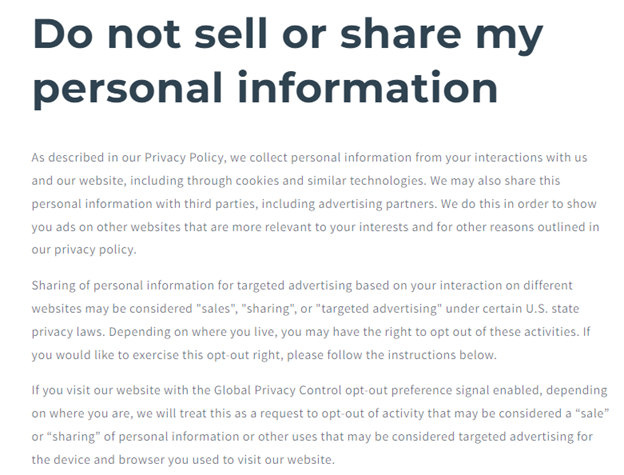
The disclosure provides users with transparency about how the brand collects, shares, and uses their personal information. It also informs them of their rights to opt-out, which shows users that their privacy preferences are respected.
4. Deliver Ads That Match Current Interests
Contextual advertising focuses on what your audience is interested in right now, rather than what they searched for weeks ago.
This makes your ads more relevant and engaging. For instance, if a user is reading an article about summer fashion trends, an ad for sunglasses or summer dresses will feel timely and useful.
The 4 Best Platforms To Make Your Contextual Ads Successful
Pay attention to the unique digital advertising tools each platform offers, and prioritize which ones can drive the most impact for your contextual ads.
1. Brandignity
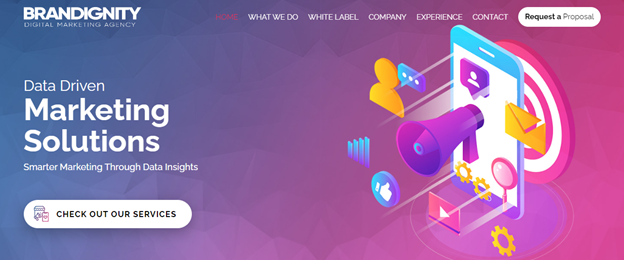
Brandignity’s PPC campaign expertise can help you deliver contextually relevant ads that surely resonate with your audience. We can help you target the right keywords and contexts to maximize your ad spend and drive higher engagement and conversions.
Additionally, our SEO services can help optimize your website’s content for relevant keywords. This improves the chances of the ads being served alongside the most appropriate content.
Whether you’re looking to improve your website’s SEO, run a PPC campaign, or enhance your brand’s overall online presence, Brandignity can help. For beginners, we also provide consultation services to help you set up your campaigns and maximize their impact.
2. Media.net
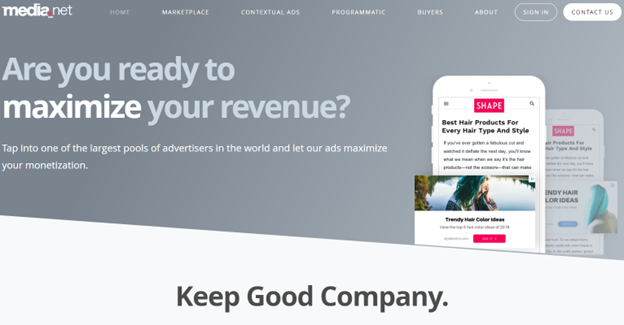
Media.net uses a sophisticated algorithm to match ads and blend them seamlessly with web pages to improve the user experience. It also lets you easily activate various ad formats—like contextual ads, outstream video ads, in-read native ads, and standard IAB units—without the hassle of extra code or integrations.
Then, its system takes care of the rest. It automatically optimizes and delivers the ad type that’s most likely to resonate with your audience. Media.net is a good choice if you want a platform that combines innovative technology with a user-friendly interface. It is particularly effective since it gives advertisers access to the Yahoo! Bing network.
3. Google AdSense
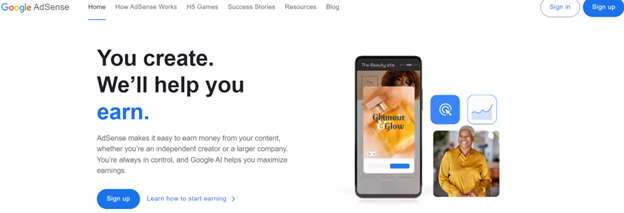
Google AdSense is one of the most well-known platforms for contextual advertising. It allows publishers and advertisers to earn money by displaying targeted ads on websites and apps.
Google AdSense uses powerful algorithms to match ads with relevant content to make sure your ads are seen by users who are most likely to be interested.
If you are looking for a reliable, easy-to-use platform that offers extensive reach and proven results, Google AdSense is a top choice.
Conclusion
As we wrap up and you get a grasp of what is contextual advertising, start to put your knowledge into action. So dive into your analytics, identify where the contextual ads can have the most impact, and start experimenting.
Your goal? To make every ad feel like a helpful suggestion rather than a hard sell.
So ask yourself: How can you use real-time data and consumer insights to make your ads even more relevant and engaging?
You can talk to us at Brandignity and find out how we can help enhance your strategy. With us, you can see real improvements in ROI and customer relationships. Contact us now and let’s get started.








